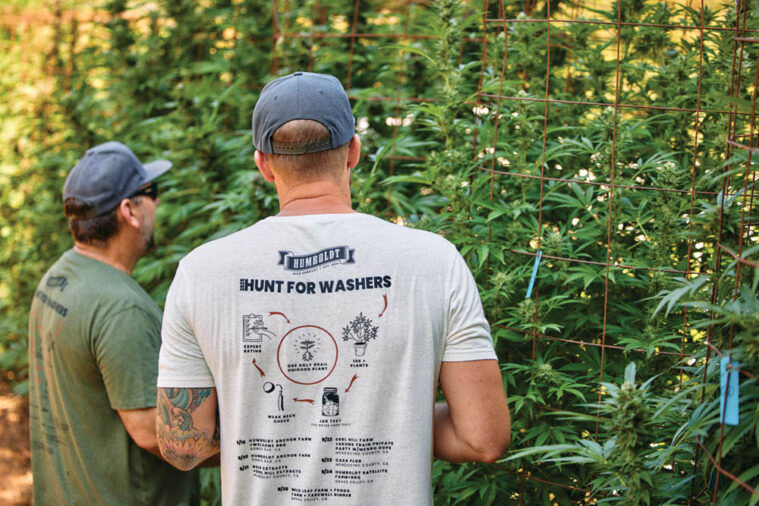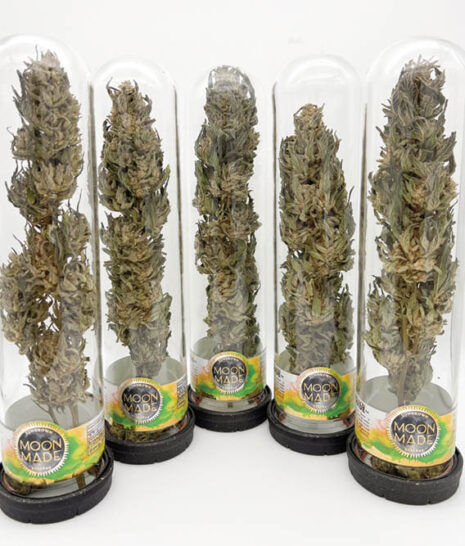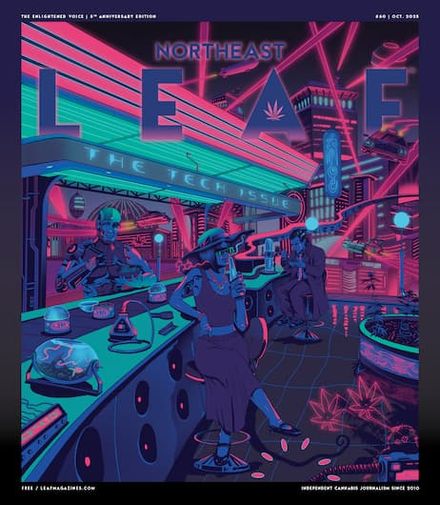I’m looking up toward a sky dappled with clouds and feeling the vibrations emanating from the life-form beside me. It’s a towering Blueberry Pancakes plant, and I’m pushing away from the energy of the group to stand in stillness with the silent hum of its life force.
The Cannabis flowers are a deep emerald green, huge and frosty, and they smell like blueberries at peak ripeness. Held in minimal trellising, the plant’s branches confidently stretch out into the air. Watching it sway in the wind over the valley of oaks below makes me smile. When I touch the flowers, they leave a lingering perfume on my fingertips. This plant is statuesque, natural, beautiful and alive.
I’m on a Humboldt Seed Company farm in the foothills of the Sierra Nevada near Grass Valley, California, as a part of the company’s 2025 quest to find the world’s best weed. Alongside me on this odyssey are Leaf’s chief operating officer, Tom Bowers, and fellow Leaf contributor David Downs.
This festive occasion in late September brings together a group to de-leaf and buck the flowers for steam distilling into terpenes for their aroma and flavor. Later, I’ll joyously dance in a fog machine that’s wafting the Blueberry Pancakes scent. I’ll eat whipped cream infused with the plant’s essential essence. I’ll inhale other Cannabis flowers into my lungs as a soft, warm rain begins to fall and a lightning storm sends wavy electric jolts across the horizon.

But when I watch the flowers I’ve “big-leafed” fall into the bin, I feel a bit of heartache at the impermanence of it all. It’s the type of melancholy that can come when we mortals think about what comes in the end for us and for every living thing. And I’ll tell my friends: “There could have been another way.”
In my home grow on my rooftop balcony in Oakland, California, I feel a similar sense of loss when harvest time comes. The Cannabis plants on my front porch provide a welcoming display of lush greenery that I enjoy looking at as they grow and mature. But once the fall comes, they’re gone, and I miss them, even just for their decoration.
A 2022 study published in the International Journal of Environmental Research and Public Health shows that even a small amount of greenery in an urban environment can be beneficial for reducing stress, as elements of nature provide a “soft charm” that allows people to achieve more efficient concentration.
A Flower With Three Lives

I think Cannabis flowers (and all flowers) are here to teach us about impermanence. With flowers — which grow, blossom and fade — the only real moments are in the now. I smell and smoke Cannabis flowers and remember that their time, and my time, here on Earth will not go on forever.
I’m probably in the minority group of people when it comes to thinking about harvest as an ending for the Cannabis plant and not a beginning to its ultimate purpose: all the weed we’re going to smoke when wintertime arrives. But I know I’m far from the only one to fall in love with a Cannabis plant.
Tina Gordon, the cultivator at Moon Made Farms in Humboldt County, believes the Cannabis plant has three lives. The first life, she said, is when it’s growing in the ground, “and that’s when the cultivator is stewarding the plant.” The second life begins when the flower is cut, and that life continues all the way up to when it’s smoked. The third life starts within the resonance of a person when they smoke that flower.
This third life of Cannabis that Gordon speaks of alludes to our deeply personal connections with this plant because of the way it makes us feel. I think the reason this plant resonates so clearly with so many different people has to do with the fact that our bodies are built with an endocannabinoid system, which has receptors that bind to the chemical elements Cannabis provides when we ingest it. The endocannabinoid system regulates critical bodily functions. It’s the key to our health and vitality.
Sure, other plants contain cannabinoids. Who can deny the sharp appeal of freshly ground black pepper or the soothing effects of cacao? But cannabinoids are most prevalent in the Cannabis plant. And while we know a lot about this plant, there are still undiscovered cannabinoids. We’re also continually learning more about how the other chemical elements in Cannabis affect our well-being.
A Time of Reflection

The Cannabis plant is our companion that helps us as we navigate through life and guides us toward asking the big questions, like “Why are we here?” Harvest brings a moment of reflection, even though it’s an intense time for growers. It’s a mad rush against the rain, a battle against hungry caterpillars, a phase when a few missteps in drying can ruin a year’s worth of effort. But at a certain point, it’s all over.
“To harvest or render the plant, it’s the culmination of everything that has gone into the plant,” Gordon said. “I mean, it happened. Here she is.”
The seasons help mark the passage of time and offer rhythmic resets that are in line with the Earth and nature around us. It’s best to think of everything, all of life, as an infinite loop. In the same way that there is no beginning, there is no end. Cannabis flowers are meant for smoking. Their ultimate destiny is helping us fulfill our destiny.
We’re getting close to reaping the benefits of the 2025 sun-grown Cannabis harvest. It’s almost time to open the jars, pull out the flowers and set them on fire. In the days with the least sunlight ahead, these flowers will provide warmth in the darkest days. We’ll settle into winter’s reset, and when spring comes, we’ll plant seeds and start over again.
humboldtseedcompany.com | @thehumboldtseedcompany | moonmadefarms.com | @moonmadefarms









